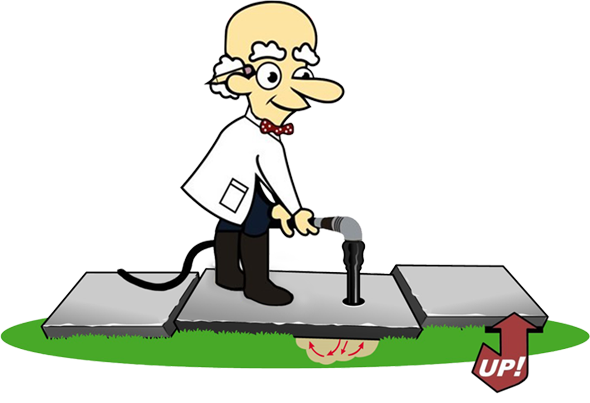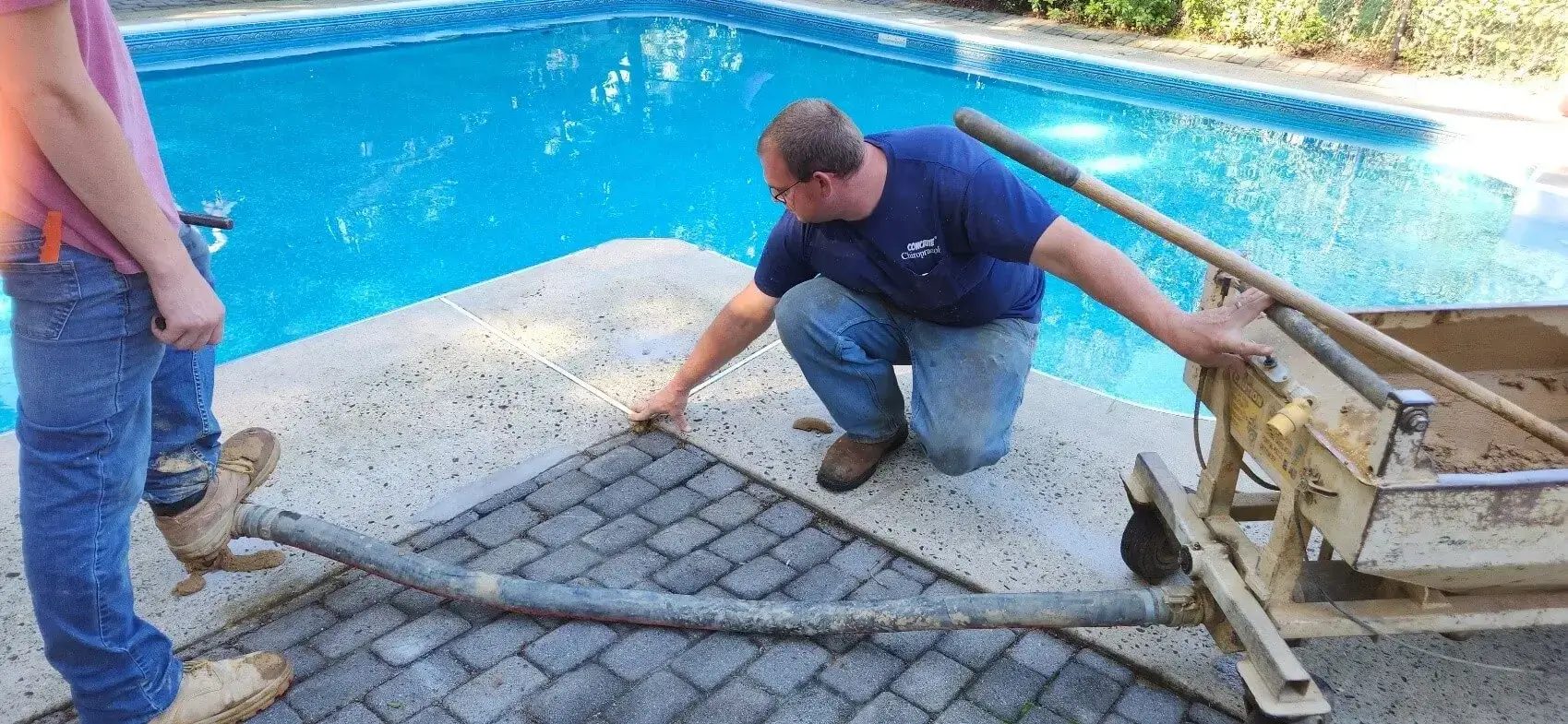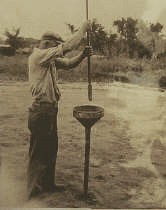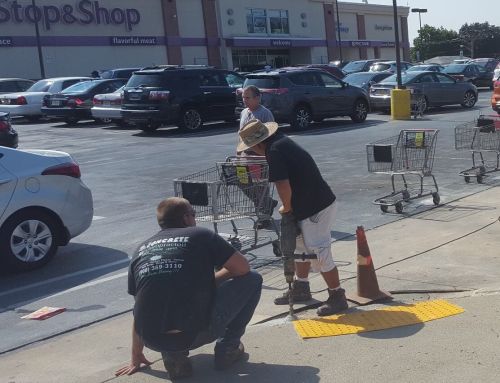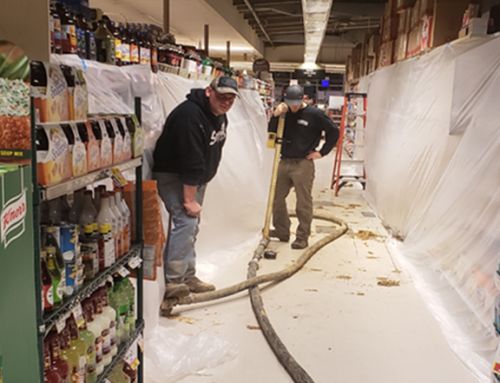IN THIS ARTICLE
Why Mudjacking Matters for New Jersey Homeowners
If you live in New Jersey, you’ve probably seen or experienced the problem of sinking concrete. Driveways start sloping the wrong way, sidewalks dip at the edges, and patios develop uneven surfaces that collect water. These issues are not only frustrating but can also create safety hazards for your family and visitors. That is where mudjacking comes in.
At Concrete Chiropractor®, we have been helping homeowners across New Jersey restore their concrete surfaces for more than 20 years. Our focus has always been on providing a cost-effective and long-lasting solution without the need for complete concrete replacement. Many people are surprised to learn that most uneven slabs do not need to be ripped out and re-poured. In most cases, they can be lifted, leveled, and stabilized using mudjacking, also called slabjacking.
You might be wondering, what exactly is mudjacking, how does it work, and how much will it cost in New Jersey?
This guide will give you clear answers. We will walk you through the history of the method, the process we use on actual NJ properties, the average costs you can expect, and why thousands of homeowners have chosen us for their projects. By the time you finish reading, you will know whether mudjacking is the right option for your home, and you will understand the value it offers compared to replacement.
If you’re tired of tripping over an uneven sidewalk or watching water pool in the wrong place on your driveway, mudjacking could be the simple solution you need.
What is Mudjacking (Slabjacking)?
Mudjacking, sometimes called slabjacking, is a proven method for lifting and leveling sunken concrete without replacing it. Instead of breaking up your driveway, sidewalk, or patio and pouring a new slab, we pump a specialized mixture under the existing concrete. This mixture fills the empty space beneath, supports the slab, and raises it back to its original level.
The process is straightforward, but it requires skill and the right equipment. Over time, soil beneath concrete can settle, wash away, or become compacted unevenly. When that happens, the concrete above begins to sink, tilt, or crack. You’ve probably seen sidewalks with one edge sticking up higher than the next, creating a tripping hazard. That’s exactly the kind of problem mudjacking solves.
Here’s how it works: we drill small holes in the slab—usually about the size of a quarter. Through those holes, we pump in a grout mixture under pressure. As the grout fills the voids, it pushes the concrete slab upward until it’s level again. Once the area is stable, we patch the holes with fresh concrete. The result is a smooth, even surface you can use again in a short time.
One of the best parts is that mudjacking preserves your existing concrete. You don’t lose the original surface, color, or finish. This is especially important if your driveway or patio has aged in place with the rest of your home and blends naturally with its surroundings. Replacing it with brand-new concrete often looks out of place, but with mudjacking, your slab simply looks like it did before the sinking happened.
At The Concrete Chiropractor®, we’ve used this method on countless New Jersey properties—everything from small residential walkways to large commercial floors. It’s a time-tested solution that saves money, reduces waste, and minimizes disruption to your daily life.
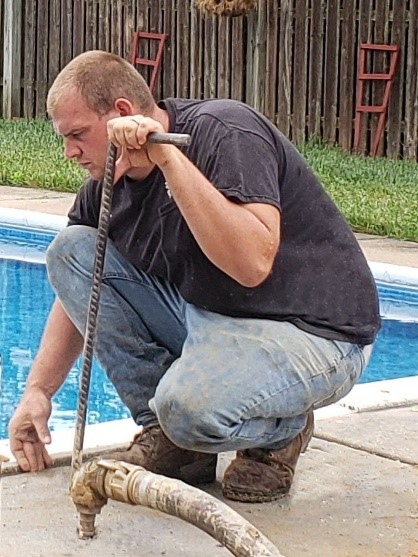
A Brief History of Mudjacking
Mudjacking is not a new idea. The technique has been around for almost a century, and it was first used in the early 1900s to correct sinking concrete on highways, airport runways, and large industrial floors. Back then, replacing big sections of concrete was expensive and time-consuming, so engineers needed a smarter way to keep surfaces safe and functional. Pumping material underneath a slab to lift it proved to be the answer.
The earliest versions of mudjacking used very simple mixtures. Contractors often pumped mud, sand, or a slurry made from soil and water beneath the slab. While this worked, the materials weren’t always consistent, and sometimes they would wash out again over time. Despite those limitations, the concept showed that concrete could be lifted and supported without full replacement.
Over the decades, the process improved. By the 1950s and 60s, contractors began experimenting with cement-based mixtures. These provided more stability, resisted erosion better than plain soil, and gave longer-lasting results. This is the point where mudjacking really became a dependable solution for homeowners and businesses alike.
Today, the process continues to evolve. At The Concrete Chiropractor®, we use a carefully mixed grout that’s designed to fill voids and provide strong support without breaking down. The equipment is also more advanced. Pumps are precise, allowing us to raise slabs gradually and carefully until they are back in place.
For New Jersey homeowners, the long history of mudjacking is a benefit. It means this is not an experimental fix or a quick patch. It’s a method with decades of proven success. When we work on a driveway or sidewalk in towns across NJ, we know we’re using a solution that has been tested in demanding environments like highways and airports. That history gives us confidence, and it should give you peace of mind, too.
The Mudjacking Process (Step by Step)
When people hear about mudjacking for the first time, it almost sounds too simple. Drill a few holes, pump in material, and suddenly your driveway or sidewalk is level again. In reality, while the concept is straightforward, the process requires precision and experience. Here’s how we at The Concrete Chiropractor® handle each project in New Jersey:
- Inspection and Evaluation
Every job starts with a careful inspection. We look at the slab, the cracks, and the surrounding soil. Our goal is to figure out why the concrete sank in the first place. Poor drainage, loose fill soil, or erosion from nearby water can all create voids under the slab. By identifying the cause, we make sure the repair lasts. - Drilling Small Holes
Once we understand the problem, we drill small holes in the concrete slab. These holes are usually about 1in diameter and strategically placed where they will do the most good. Placement matters because the grout needs to spread evenly under the slab. - Pumping the Grout
Next comes the heart of the process. We pump our specially mixed grout through the holes under controlled pressure. The material fills empty spaces under the slab, and as it builds up, it gently raises the concrete. This step requires a steady hand—too much pressure can crack the slab, while too little won’t lift it enough. - Monitoring the Lift
We don’t just pump and walk away. As the grout flows underneath, we monitor the lift in real time. The slab rises slowly, often just fractions of an inch at a time, until it’s back to its original level. This precision is what separates professionals from quick, low-quality jobs. - Patching the Holes
Once the slab is in place and the voids are filled, we patch the drilled holes with fresh cement. The patches blend in, leaving the surface looking smooth again. Over time, they weather with the rest of the slab and become barely noticeable. - Cleanup and Final Check
Finally, we clean up the work area and double-check that the slab is stable. We make sure the surface is safe for walking and, after the recommended setting period, ready for vehicles if it’s a driveway.
The whole process usually takes just a few hours, depending on the size of the project. The result is a level, supported slab without the high cost and disruption of replacement. For homeowners in New Jersey, this means you can fix sinking concrete in the morning and often walk on it later the same day.
Cost of Mudjacking
One of the first questions most homeowners ask us is, “How much will it cost to fix my concrete?” It’s a fair question because repairs need to make sense financially. The good news is that mudjacking is almost always more affordable than tearing out and replacing concrete. In New Jersey, the cost depends on several factors, but here’s what you can expect.
Average Range
In most cases, mudjacking costs between $7 and $10 per square foot. For a small sidewalk, you might spend $1000. For a large driveway, the price could be closer to $2,000. Still, that’s usually less than half of what it would cost to replace the concrete entirely.
What Affects the Price
Several things can raise or lower the price:
- Size of the slab: Larger surfaces require more grout and more labor.
- Number of holes: More holes mean more drilling, pumping, and patching.
- Severity of settlement: A slab that has only sunk an inch or two is easier (and cheaper) to lift than one that has dropped several inches.
- Access: If the equipment can’t easily reach the work area, the job may take longer and cost more.
Comparing to Replacement
Replacing concrete typically costs $10 to $18 per square foot, not including demolition, removal, and disposal of the old slab. That can add thousands to the bill. Beyond the money, replacement is messier, louder, and leaves you waiting weeks before you can fully use the new concrete.
Value in the Long Run
Mudjacking is not just about the lower price—it’s also about preserving your existing concrete. A properly lifted and stabilized slab can last for decades if the soil underneath remains stable. That means you save money now and avoid the disruption of replacement.
When you add it all up, mudjacking provides strong value for homeowners who want a safe, level surface without overspending. You can walk away with the peace of mind that your repair is cost-effective and reliable.
Benefits of Mudjacking vs Replacement
When concrete settles, you really only have two main choices: lift what you already have or tear it out and pour new concrete. On the surface, replacement might sound like a clean slate. But in reality, mudjacking has several advantages that often make it the smarter option.
Cost Savings
We’ve worked with countless homeowners across New Jersey, and almost everyone is surprised by how much they save with mudjacking. On average, you’ll pay 50–70% less than replacement. That means money stays in your pocket while your concrete gets a second life.
Speed of the Process
Tearing out and replacing concrete is messy and time-consuming. Between demolition, hauling away debris, forming, pouring, and curing, you could be looking at weeks before you can safely park your car or use your patio. With mudjacking, we can usually complete the job in a few hours, and you’ll often be able to walk on the slab the same day. Vehicle traffic is usually fine within 24–48 hours.
Less Disruption
Replacement means jackhammers, heavy trucks, and a yard torn up by equipment. Mudjacking is minimally invasive. We drill small holes, pump in the slurry, and patch the surface. Your landscaping stays intact, and there’s no huge pile of concrete waste to haul away.
Environmentally Friendly
Every time concrete is replaced, the old slab ends up in a landfill. By lifting and reusing your existing slab, you’re cutting down on waste. The grout we use is made from natural materials, so it’s safe for the environment and long-lasting.
Preserving Aesthetic Consistency
New concrete often looks brighter than old concrete, so if you replace just one section, it rarely matches the rest of the driveway, sidewalk, or patio. With mudjacking, you keep the original slab, which means no awkward color differences.
The Bottom Line
Mudjacking makes sense for most homeowners. It saves money, time, and hassle while extending the life of the concrete you already have. Replacement still has its place—like when a slab is severely broken or crumbling—but for sinking, uneven surfaces, lifting is almost always the smarter first step.
Limitations of Mudjacking and Alternatives
Mudjacking is a strong and affordable way to repair settled concrete, but it’s not always the right fit. Like any repair method, it has boundaries, and it’s important to know when it works and when it doesn’t.
The main limitation comes down to the condition of the slab itself. Mudjacking is best when the concrete is still solid and structurally sound, but has sunk because the soil underneath shifted or washed away. If the slab is severely cracked, badly broken, or beginning to crumble, lifting it won’t solve the underlying damage. In those cases, the only real solution is to remove the slab and replace it with new concrete.
Another limitation involves what’s happening beneath the surface. Mudjacking fills the void directly under the slab to restore support, but it does not extend several feet into the soil. If the deeper ground is weak, poorly compacted, or still moving, the slab may eventually settle again. That’s why having proper drainage and stable soil conditions is just as important as the repair itself.
It’s also worth noting that mudjacking is not meant for major foundation problems. If your home’s foundation is sinking or basement walls are shifting, those situations require specialized structural repairs. Mudjacking is intended for surfaces like driveways, patios, sidewalks, garage floors, and pool decks — areas where the slab has dropped but is otherwise in good shape.
To put it simply: if your concrete is sound, mudjacking is an excellent choice. If the slab is too far gone, replacement is the only option.
Who Should Choose Mudjacking?
Mudjacking is not for every concrete problem, but for many property owners, it’s the most practical solution. If you have concrete that has sunk, tilted, or become uneven, mudjacking could be the right choice for you.
You might notice trip hazards on your sidewalks, a garage floor that slopes toward one side, or a driveway that collects puddles because it’s no longer level. These are all classic signs that mudjacking can help. Instead of tearing out and replacing the slab, we can lift it back into place.
Mudjacking is best suited for:
- Homeowners with uneven driveways, patios, steps, or pool decks. These areas often sink over time due to soil movement or erosion, but the concrete itself is still in good condition.
- Businesses and property managers who need a quick and cost-effective fix. If you’re responsible for keeping sidewalks or entryways safe, mudjacking reduces liability by removing tripping hazards without shutting down the area for weeks.
- Municipalities and schools that maintain large areas of concrete. Repair budgets stretch further with mudjacking because it’s much less expensive than full replacement.
The key factor is whether the slab is structurally sound. If the concrete is crumbling or badly cracked, replacement may be the only option. But if the surface is in good shape and only the soil underneath has shifted, mudjacking is usually the smartest choice.
In short, mudjacking is right for you if you want to save money, avoid long downtime, and restore safety and function to your concrete without starting over from scratch.
Why Choose The Concrete Chiropractor® for Mudjacking in NJ
In New Jersey, you have options when it comes to concrete repair. So why should you choose us at The Concrete Chiropractor®? The answer comes down to experience, quality, and trust.
We’ve specialized in concrete raising and leveling for more than 20 years, serving homeowners, businesses, and municipalities across New Jersey. Mudjacking isn’t just one of many services we offer—it’s what we do every day. That focus means we know how to handle everything from small patios to large commercial walkways.
When you call us, you’re dealing directly with specialists who take the time to explain the process, answer your questions, and recommend the right solution for your situation. We don’t push unnecessary work, and we don’t cut corners. Our reputation has been built on honest service and lasting results.
Here’s what you get when you work with us:
- Proven results. Many of our jobs have held strong for over 25 years.
- Affordable pricing. Mudjacking costs far less than replacement, and we make sure you get the best value for your money.
- Minimal disruption. Most jobs are done in just a few hours, and you can use the area again soon after.
- Local expertise. We understand New Jersey soils, weather patterns, and drainage challenges, which helps us provide long-lasting repairs.
We’re proud to be a trusted name in concrete repair across NJ. If you’re tired of looking at sunken slabs or worrying about safety hazards, we’d be glad to help.
- How We Raised a Sunken Concrete Walkway in Sewell, NJ - November 20, 2025
- Carbon Fiber Foundation Repair: All You Need to Know - November 20, 2025
- 5 Common Causes of Concrete Porch Collapse (and How to Prevent It) - November 20, 2025

